Crossref Citations
This article has been cited by the following publications. This list is generated based on data provided by
Crossref.
Sun, Benjamin C.
Costantino, Giorgio
Barbic, Franca
Bossi, Ilaria
Casazza, Giovanni
Dipaola, Franca
McDermott, Daniel
Quinn, James
Reed, Matthew
Sheldon, Robert S.
Solbiati, Monica
Thiruganasambandamoorthy, Venkatesh
Krahn, Andrew D.
Beach, Daniel
Bodemer, Nicolai
Brignole, Michele
Casagranda, Ivo
Duca, Piergiorgio
Falavigna, Greta
Ippoliti, Roberto
Montano, Nicola
Olshansky, Brian
Raj, Satish R.
Ruwald, Martin H.
Shen, Win-Kuang
Stiell, Ian
Ungar, Andrea
van Dijk, J. Gert
van Dijk, Nynke
Wieling, Wouter
and
Furlan, Raffaello
2014.
Priorities for Emergency Department Syncope Research.
Annals of Emergency Medicine,
Vol. 64,
Issue. 6,
p.
649.
Raj, Satish R.
2014.
Syncope and mortality: The critical component of the pathway or an innocent bystander?.
Heart Rhythm,
Vol. 11,
Issue. 11,
p.
2045.
Carpentier, F.
Cheron, G.
Levraut, J.
and
Freund, Y.
2014.
Actualités en médecine d’urgence.
Annales françaises de médecine d'urgence,
Vol. 4,
Issue. 6,
p.
419.
Cambournac-Buan, A.
Charriton Dadone, B.
and
Trinh-Duc, A.
2015.
Malore, lipotimia e sincope.
EMC - Urgenze,
Vol. 19,
Issue. 1,
p.
1.
Duska, Linda R.
Mueller, Jennifer
Lothamer, Heather
Pelkofski, Elizabeth B.
and
Novicoff, Wendy M.
2015.
Lean methodology improves efficiency in outpatient academic Gynecologic Oncology clinics.
Gynecologic Oncology,
Vol. 138,
Issue. 3,
p.
707.
Dixon, Cinnamon A
Punguyire, Damien
Mahabee-Gittens, Melinda
Ho, Mona
and
Lindsell, Christopher J
2015.
Patient Flow Analysis in Resource-Limited Settings: A Practical Tutorial and Case Study.
Global Health: Science and Practice,
Vol. 3,
Issue. 1,
p.
126.
Hogan, Teresita M.
Constantine, Stephen Tyler
and
Crain, Aoko Doris
2016.
Evaluation of Syncope in Older Adults.
Emergency Medicine Clinics of North America,
Vol. 34,
Issue. 3,
p.
601.
Adeniji, Adeloye A.
and
Mash, Bob
2016.
Patients’ perceptions of the triage system in a primary healthcare facility, Cape Town, South Africa.
African Journal of Primary Health Care & Family Medicine,
Vol. 8,
Issue. 1,
Lee, Wailliam W.
Filiatrault, Lyne
Abu-Laban, Riyad B.
Rashidi, Anita
Yau, Lawrence
and
Liu, Nancy
2016.
Effect of Triage Nurse Initiated Radiography Using the Ottawa Ankle Rules on Emergency Department Length of Stay at a Tertiary Centre.
CJEM,
Vol. 18,
Issue. 2,
p.
90.
Fanelli, Simone
Ferretti, Marco
and
Zangrandi, Antonello
2017.
The impact of regional policies on emergency department management and performance: the case of the regional government of Sicily.
The International Journal of Health Planning and Management,
Vol. 32,
Issue. 1,
p.
e83.
Lenz, Kasia
McRae, Andrew
Wang, Dongmei
Higgins, Benjamin
Innes, Grant
Cook, Timothy
and
Lang, Eddy
2017.
Slow or swift, your patients’ experience won’t drift: absence of correlation between physician productivity and the patient experience.
CJEM,
Vol. 19,
Issue. 5,
p.
372.
Le, Thang Q.
Sánchez, Yadiel
Saini, Sanjay
Sheridan, Robert
Hirsch, Joshua A.
and
Prabhakar, Anand M.
2017.
Improving the Interventional Radiology Patient Experience: Effect of a Phone Communication System Revision.
Journal of the American College of Radiology,
Vol. 14,
Issue. 8,
p.
1045.
Sun, Jing
Lin, Qian
Zhao, Pengyu
Zhang, Qiongyao
Xu, Kai
Chen, Huiying
Hu, Cecile Jia
Stuntz, Mark
Li, Hong
and
Liu, Yuanli
2017.
Reducing waiting time and raising outpatient satisfaction in a Chinese public tertiary general hospital-an interrupted time series study.
BMC Public Health,
Vol. 17,
Issue. 1,
Olwanda, Easter
Shen, Jennifer
Kahn, James G.
Bryant-Comstock, Katelyn
and
Huchko, Megan J.
2018.
Comparison of patient flow and provider efficiency of two delivery strategies for HPV-based cervical cancer screening in Western Kenya: a time and motion study.
Global Health Action,
Vol. 11,
Issue. 1,
p.
1451455.
Asamrew, Nebsu
Endris, Abduilhafiz A.
and
Tadesse, Musse
2020.
Level of Patient Satisfaction with Inpatient Services and Its Determinants: A Study of a Specialized Hospital in Ethiopia.
Journal of Environmental and Public Health,
Vol. 2020,
Issue. ,
p.
1.
Ortíz-Barrios, Miguel Angel
and
Alfaro-Saíz, Juan-José
2020.
Methodological Approaches to Support Process Improvement in Emergency Departments: A Systematic Review.
International Journal of Environmental Research and Public Health,
Vol. 17,
Issue. 8,
p.
2664.
Borensztajn, Dorine M.
Hagedoorn, Nienke N.
Carrol, Enitan D.
von Both, Ulrich
Dewez, Juan Emmanuel
Emonts, Marieke
van der Flier, Michiel
de Groot, Ronald
Herberg, Jethro
Kohlmaier, Benno
Lim, Emma
Maconochie, Ian K.
Martinon-Torres, Federico
Nieboer, Daan
Nijman, Ruud G.
Oostenbrink, Rianne
Pokorn, Marko
Calle, Irene Rivero
Strle, Franc
Tsolia, Maria
Vermont, Clementien L.
Yeung, Shunmay
Zavadska, Dace
Zenz, Werner
Levin, Michael
and
Moll, Henriette A.
2021.
A NICE combination for predicting hospitalisation at the Emergency Department: a European multicentre observational study of febrile children.
The Lancet Regional Health - Europe,
Vol. 8,
Issue. ,
p.
100173.
Sagaidak, Sofia
Rowe, Brian H.
Ospina, Maria B.
and
Rosychuk, Rhonda J.
2021.
Emergency department crowding negatively influences outcomes for children presenting with asthma: a population-based retrospective cohort study.
Pediatric Research,
Vol. 89,
Issue. 3,
p.
679.
Freund, Ophir
Caspi, Inbar
Shacham, Yacov
Frydman, Shir
Biran, Roni
Abu Katash, Hytham
Zornitzki, Lior
and
Bornstein, Gil
2022.
Holter ECG for Syncope Evaluation in the Internal Medicine Department—Choosing the Right Patients.
Journal of Clinical Medicine,
Vol. 11,
Issue. 16,
p.
4781.
Kynoch, Kathryn
Ameen, Mary
Ramis, Mary-Anne
and
Khalil, Hanan
2022.
Use of Patient-Reported Data within the Acute Healthcare Context: A Scoping Review.
International Journal of Environmental Research and Public Health,
Vol. 19,
Issue. 18,
p.
11160.




